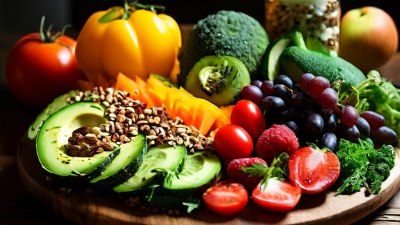Farm to Table: The Journey of Your Food from Field to Plate
Explore the fascinating journey of plant-based food from farm to table! We will take you through each step of the process, from planting seeds to nurturing growth, harvesting, and finally reaching your plate. Embrace fresh produce in your daily life!

This image was created with the assistance of Playground AI
Ever wondered about the journey your food takes from the farm to your plate? 🌱🍽️
This fascinating process involves numerous steps that ensure you get the freshest, most nutritious produce. Let’s take a closer look at the farm-to-table journey of plants and understand how they make their way from the field to your kitchen.
Step 1: Planting the Seeds 🌾
The journey begins with the planting of seeds. Farmers carefully select high-quality seeds that are best suited for their climate and soil. This crucial step lays the foundation for a successful harvest.
- Selection: Farmers choose seeds based on factors like climate, soil type, and resistance to pests and diseases.
- Sowing: Seeds are planted using various methods, including direct seeding in fields or starting in greenhouses before being transplanted.
Step 2: Nurturing Growth 🌞
Once the seeds are planted, they need the right conditions to grow. This involves regular watering, fertilizing, and protecting the young plants from pests and diseases.
- Irrigation: Plants need consistent moisture to grow. Farmers use irrigation systems to ensure that crops receive the right amount of water.
- Fertilization: Nutrients are essential for plant growth. Farmers use organic fertilizers to enrich the soil and promote healthy plant development.
- Pest Control: Organic farming methods often include natural pest control techniques, such as introducing beneficial insects or using natural repellents.
Step 3: Harvesting the Crops 🌽
When the plants are fully grown and ripe, it’s time for the harvest. This is one of the most labor-intensive parts of the farm-to-table journey.
- Timing: Harvesting at the right time ensures maximum flavor and nutrition. Farmers monitor their crops closely to pick them at peak ripeness.
- Methods: Depending on the crop, harvesting can be done by hand or with the help of machinery. For delicate plants like tomatoes, hand-picking is often preferred to avoid damage.
Step 4: Transporting to Markets 🛒
Once harvested, the fresh produce needs to be transported to markets, grocery stores, or directly to restaurants and consumers.
- Packaging: Produce is carefully packaged to protect it during transit. Sustainable packaging options are becoming increasingly popular to reduce environmental impact.
- Transportation: Efficient transportation is key to maintaining freshness. Farmers often use refrigerated trucks to keep produce cool during transit.
Step 5: Reaching Your Plate 🍽️
Finally, the produce arrives at its destination, ready to be enjoyed by consumers. Whether it’s sold at a local farmers’ market, a grocery store, or delivered directly to your door, fresh produce is now ready for your kitchen.
- Farmers’ Markets: These markets provide a direct link between farmers and consumers, offering fresh, local produce and the opportunity to learn more about where your food comes from.
- Grocery Stores: Many grocery stores now feature sections dedicated to locally sourced produce, highlighting the farm-to-table journey.
- Home Deliveries: Some farms offer subscription services, delivering fresh produce directly to your home, ensuring you always have access to seasonal fruits and vegetables.
The Benefits of Farm-to-Table 🌍
The farm-to-table movement offers numerous benefits for your health, the community, and the environment:
- Freshness: Eating produce that’s freshly harvested means better taste and higher nutritional value.
- Supporting Local Farmers: Buying locally supports small farms and contributes to the local economy.
- Environmental Impact: Local sourcing reduces the carbon footprint associated with long-distance transportation and promotes sustainable farming practices.
Practical Tips for Embracing Farm-to-Table
- Shop Local: Visit farmers’ markets or join a CSA (Community Supported Agriculture) program to get fresh, local produce.
- Grow Your Own: If possible, try growing some of your own vegetables and herbs at home.
- Seasonal Eating: Focus on eating produce that’s in season. It’s fresher, more flavorful, and often more affordable.
Understanding the journey of your food from farm to table can deepen your appreciation for the fresh produce you enjoy every day. So next time you bite into a crisp apple or savor a fresh salad, take a moment to think about the incredible journey it took to get to your plate. 🌱🍎



























